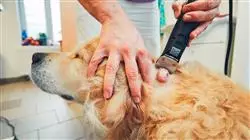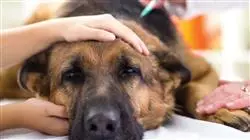University certificate
The world's largest faculty of veterinary medicine”
Introduction to the Program
This Professional master’s degree is organized so that the deepening of knowledge is logical and intuitive and allows the consolidation of diagnostic, therapeutic and monitoring protocols"

In the veterinary profession, Internal Medicine is the fundamental pillar on which the practice of the profession is based, being closely linked to other specialties. In the last few decades, the knowledge about the pathophysiology of numerous processes and pathologies in animals has evolved notoriously, as well as the methodology, resources and diagnostic techniques. Great advances have also been made in the monitoring and therapy of these pathologies, which have led to a higher success rate both in the effective and early diagnosis of these processes and in the stabilization and control of these patients, which translates into a better quality of life and longevity.
The Professional master’s degree in Small Animal Internal Medicine was created in response to the need of clinical veterinarians to expand the specific knowledge of Internal Medicine, as well as the approach of protocols and diagnostic techniques, therapeutics and relationship with other specialties.
The topics presented in this program have been selected with the aim of offering a complete, up-to-date and quality specialization in Internal Medicine, in such a way that the student acquires the appropriate knowledge to deal safely with the cases, as well as to be able to carry out an adequate follow-up, monitoring and therapy.
At present, one of the problems that conditions continuous postgraduate specialization is its reconciliation with work and personal life. Current professional demands make it difficult to provide quality, specialized, face-to-face education, so the online format will allow our students to reconcile this specialized training with their daily professional practice.
Specialize with us and learn how to diagnose and treat diseases in small animals to improve the quality of their lives”
This Professional master’s degree in Small Animal Internal Medicine contains the most complete and up-to-date educational program on the market. Its most important features include:
- Case studies presented by experts in Small Animal Internal Medicine
- The graphic, schematic, and practical contents with which they are created provide scientific and practical information on the disciplines, essential for professional development
- Latest information on Small Animal Internal Medicine
- Practical exercises where the self-assessment process can be carried out to improve learning
- Its special emphasis on innovative methodologies in Small Animal Internal Medicine
- Theoretical lessons, questions to the expert, debate forums on controversial topics, and individual reflection work
- Content that is accessible from any fixed or portable device with an Internet connection
This 100% online Professional master’s degree allows you to combine your studies with professional commitments while you expand your knowledge in the field”
Its teaching staff includes professionals from the veterinary field, who bring the experience of their work to this training, as well as recognised specialists from leading societies and prestigious universities.
Its Multimedia Content, elaborated with the latest Educational Technology, will allow the Professional a situated and contextual learning, that is to say, a Simulated Environment that will provide an immersive specialization programmed to train in real situations.
This program is designed around Problem Based Learning, whereby the specialist must try to solve the different professional practice situations that arise during the academic year. For this purpose, the professional will be assisted by an innovative interactive video system developed by renowned and experienced experts in Internal Medicine in Small Animals.
This training comes with the best didactic material, which will provide you with a contextual approach that in turn facilitates learning"

You will learn to elaborate a complete differential diagnosis that will allow you to reach a definitive diagnosis of endocrinopathies"
Why study at TECH?
TECH is the world’s largest online university. With an impressive catalog of more than 14,000 university programs available in 11 languages, it is positioned as a leader in employability, with a 99% job placement rate. In addition, it relies on an enormous faculty of more than 6,000 professors of the highest international renown.

Study at the world's largest online university and guarantee your professional success. The future starts at TECH”
The world’s best online university according to FORBES
The prestigious Forbes magazine, specialized in business and finance, has highlighted TECH as “the world's best online university” This is what they have recently stated in an article in their digital edition in which they echo the success story of this institution, “thanks to the academic offer it provides, the selection of its teaching staff, and an innovative learning method aimed at educating the professionals of the future”
A revolutionary study method, a cutting-edge faculty and a practical focus: the key to TECH's success.
The most complete study plans on the university scene
TECH offers the most complete study plans on the university scene, with syllabuses that cover fundamental concepts and, at the same time, the main scientific advances in their specific scientific areas. In addition, these programs are continuously being updated to guarantee students the academic vanguard and the most in-demand professional skills. In this way, the university's qualifications provide its graduates with a significant advantage to propel their careers to success.
TECH offers the most comprehensive and intensive study plans on the current university scene.
A world-class teaching staff
TECH's teaching staff is made up of more than 6,000 professors with the highest international recognition. Professors, researchers and top executives of multinational companies, including Isaiah Covington, performance coach of the Boston Celtics; Magda Romanska, principal investigator at Harvard MetaLAB; Ignacio Wistumba, chairman of the department of translational molecular pathology at MD Anderson Cancer Center; and D.W. Pine, creative director of TIME magazine, among others.
Internationally renowned experts, specialized in different branches of Health, Technology, Communication and Business, form part of the TECH faculty.
A unique learning method
TECH is the first university to use Relearning in all its programs. It is the best online learning methodology, accredited with international teaching quality certifications, provided by prestigious educational agencies. In addition, this disruptive educational model is complemented with the “Case Method”, thereby setting up a unique online teaching strategy. Innovative teaching resources are also implemented, including detailed videos, infographics and interactive summaries.
TECH combines Relearning and the Case Method in all its university programs to guarantee excellent theoretical and practical learning, studying whenever and wherever you want.
The world's largest online university
TECH is the world’s largest online university. We are the largest educational institution, with the best and widest online educational catalog, one hundred percent online and covering the vast majority of areas of knowledge. We offer a large selection of our own degrees and accredited online undergraduate and postgraduate degrees. In total, more than 14,000 university degrees, in eleven different languages, make us the largest educational largest in the world.
TECH has the world's most extensive catalog of academic and official programs, available in more than 11 languages.
Google Premier Partner
The American technology giant has awarded TECH the Google Google Premier Partner badge. This award, which is only available to 3% of the world's companies, highlights the efficient, flexible and tailored experience that this university provides to students. The recognition as a Google Premier Partner not only accredits the maximum rigor, performance and investment in TECH's digital infrastructures, but also places this university as one of the world's leading technology companies.
Google has positioned TECH in the top 3% of the world's most important technology companies by awarding it its Google Premier Partner badge.
The official online university of the NBA
TECH is the official online university of the NBA. Thanks to our agreement with the biggest league in basketball, we offer our students exclusive university programs, as well as a wide variety of educational resources focused on the business of the league and other areas of the sports industry. Each program is made up of a uniquely designed syllabus and features exceptional guest hosts: professionals with a distinguished sports background who will offer their expertise on the most relevant topics.
TECH has been selected by the NBA, the world's top basketball league, as its official online university.
The top-rated university by its students
Students have positioned TECH as the world's top-rated university on the main review websites, with a highest rating of 4.9 out of 5, obtained from more than 1,000 reviews. These results consolidate TECH as the benchmark university institution at an international level, reflecting the excellence and positive impact of its educational model.” reflecting the excellence and positive impact of its educational model.”
TECH is the world’s top-rated university by its students.
Leaders in employability
TECH has managed to become the leading university in employability. 99% of its students obtain jobs in the academic field they have studied, within one year of completing any of the university's programs. A similar number achieve immediate career enhancement. All this thanks to a study methodology that bases its effectiveness on the acquisition of practical skills, which are absolutely necessary for professional development.
99% of TECH graduates find a job within a year of completing their studies.
Professional Master's Degree in Small Animal Internal Medicine
.
In order to perform a correct diagnosis and prescription process regarding the pathologies that affect animal organs, it is essential to have specialized medical knowledge in the anatomical and physiological aspects involved in such complications. Taking into account this academic and professional need, at TECH Global University we have created this Professional Master's Degree focused on the rigorous study of diseases and their possible curative-therapeutic interventions. During the 12 months required, students will study infections, cardiorespiratory, digestive, genitourinary, neurological and endocrine disorders, as well as those related to ophthalmology, dermatology, hematology and oncology. Subsequently, depending on the specialty, the different diagnostic techniques will be discussed: biochemical markers, electrolyte evaluation, acid-base balance analysis, urine/cavitary fluid analysis, radiology and abdominal ultrasound. At the end of this thematic tour, professionals will be able to adequately approach their patients, analyze their health status and, based on this, raise differential assessments that allow treating the symptomatology.
Postgraduate course in Small Animal Internal Medicine
.
With this postgraduate course at TECH, veterinarians will have the opportunity to strengthen their skills in daily practice, since, thanks to the case analysis methodology and problem-based learning, they will face real medical conditions, both common and complex, which they will have to solve through the mobilization of analytical and communicative skills. This enables them, among other things, to make decisions regarding the choice of tests and the type of therapeutic-pharmacological prescription, key dilemmas in each of the stages of this process. Likewise, the program offers essential tools for the design, development and management of differential diagnosis protocols, where all the clinical signs are compiled and the functioning of the principles, structures and patterns of the pathology in the patient's organism is verified. This design will, in turn, favor the construction of personalized follow-up control plans that facilitate the establishment of treatments. In this way, the future expert in small animal internal medicine will manage to provide comprehensive quality care, oriented to assisted intervention and health promotion, through prevention campaigns, complying, of course, with the ethical and legal codes demanded by his profession.







